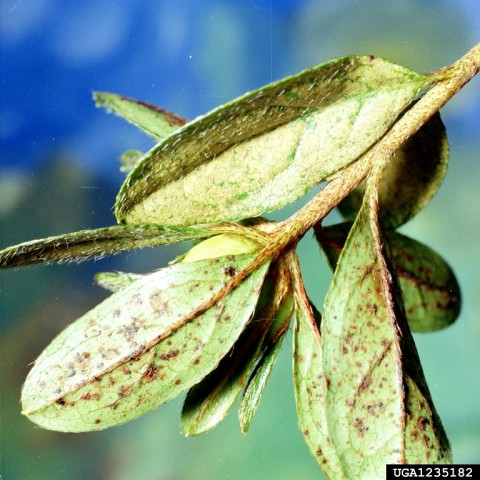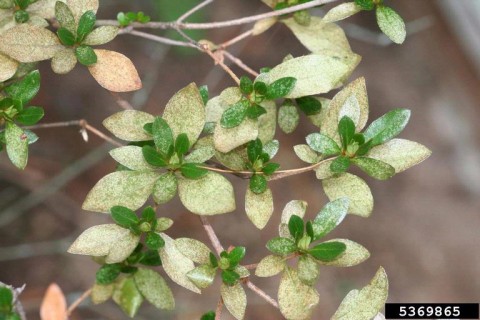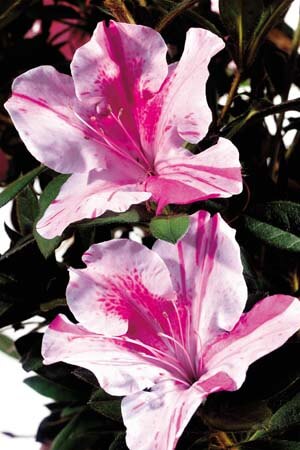Plants that are drought stressed are more susceptible to insect pests and diseases. As we discussed in last week’s post about drought stress in trees, stressed plants often emit distress signals that many damaging insects pick up on.
We are seeing signs of lace bug damage on rhododendrons and azaleas in some of our clients’ landscapes. We also sometimes see damage on other broadleaf evergreens such as pieris. Damage may be especially apparent when the plants are also showing signs of stress from too little water.
Given our current hot, dry weather, we decided to update a blog post from last year about managing this pest. Unfortunately, at this time of year there is little you can do except to keep your plants well watered. But you can begin planning for a better situation next year.

Lace bug damage on rhododendron. Photo: Clemson University – USDA Cooperative Extension Slide Series, Bugwood.org
How to tell if you have lace bugs
When lace bugs feed, they cause yellow pinpoints in the leaves. Heavily damaged leaves appear yellow. Lace bugs suck the life out of leaf tissue and may eventually kill your shrubs.
Lace bugs are about 1/8 inch long. They have clear wings sporting dark blotches in a lacy pattern. Eggs appear as black or brown dots on the underside of leaves. Nymphs look like tiny clear, yellow or black spiky things. Females lay eggs partly into the plant tissue, hidden under poop.
There are several types of lace bugs, including the rhododendron lace bug and the azalea lace bug. The latter is a native of Japan. It has only been found in the Pacific Northwest since 2008.
What we can do
Contact us if you would like help controlling lace bugs. We use M-Pede oil to reduce populations. It is made from a fatty acid. It’s safe and has limited effects on beneficial insects. We start monitoring for lace bugs in our clients’ landscapes in spring because nymphs are easier to kill than adults.

Evergreen shrubs with lace bug damage now will continue to show damage until leaves drop in two years. Photo: Whitney Cranshaw, Colorado State University, Bugwood.org.
What you can do
- Keep your plants well watered and don’t over-fertilize. Watch our video on how to water to make your plants strong and healthy. Stressed plants (e.g., from too much sun) are more likely to be damaged by lace bugs. Most rhododendrons and azaleas prefer partial shade. A healthy plant will better resist insect damage.
- Don’t rake everything out of the beds. Leave mulch to protect roots. Make sure roots are not exposed. Thick layers of mulch also help reduce drought stress.
- Apply mulch or compost to beds in fall or spring when soil is moist and cool. Mulch keeps moisture in the soil and prevents shrubs from drying out. Remember to keep a 6-8 inch space between mulch and the plant stem.
- Encourage beneficial insects by planting low-growing plants such as grasses, heather, salal, epimedium and other evergreen perennials. Several beneficial insects feed on lace bugs, including earwigs, green lacewings, lady beetles, minute pirate bugs, plant bugs, spiders and tree crickets. Research has shown that releasing lacewings among target plants reduces damage from lace bugs.
- Look for and destroy eggs and nymphs in spring. You could use a nontoxic spray such as horticultural oil, insecticidal soap and neem-based products. Coat the leaves well, including on the underside. Repeat regularly. Chemical insecticides kill important pollinators and beneficial insects that kill other pests.
- Decide how important your plant is to you and how much you want to do to manage the problem. You may choose to replace problem plants with something that takes less work to look good and stay healthy.

‘Autumn Twist’ is one of several Encore azalea cultivars that are resistant to lace bugs.
Resistant plants
- Resistant Encore azalea cultivars include ‘Autumn Amethyst’, ‘Autumn Twist’, ‘Autumn Royalty’, ‘Autumn Sangria’, ‘Autumn Cheer’, and ‘Autumn Rouge’. Among evergreen azaleas, the cultivar ‘Micrantha’ shows some resistance. Deciduous azaleas with the most resistance are Rhododendron canescens and R. periymenoides.
-
Resistant pieris varieties include Pieris phillyreifolia and P. japonica ‘Variegata.’
- If you would prefer another type of shade-tolerant flowering shrub, try native Oregon grape, red flowering currant or exotic kalmia, hydrangea, osmanthus or daphne.
References
Pests of Landscape Trees and Shrubs, an Integrated Pest Management Guide. 1994. UC Publication 3359.
Azalea Lace Bug: Biology and management in commercial nurseries and landscapes, Oregon State University.
